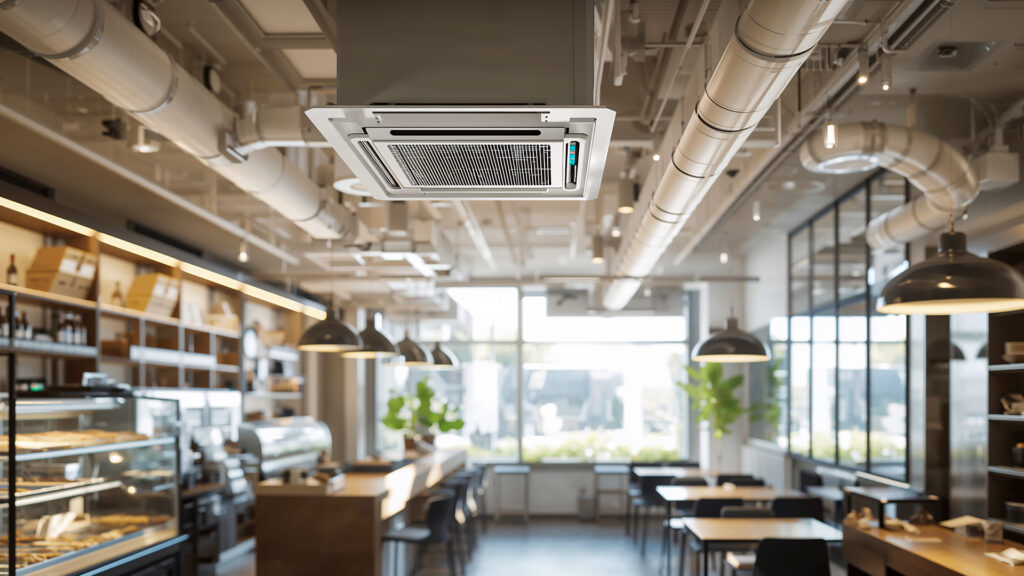

Table of Contents
ToggleKeeping a commercial space comfortable is not just a luxury; it’s a necessity. For businesses like bakeries, restaurants, and large commercial buildings in Pakistan, maintaining a cool and consistent temperature is crucial for customer satisfaction, employee productivity, and even the preservation of goods. This is where a robust Duct type Air Conditioning Solution becomes an invaluable asset. Unlike smaller, individual units, a ducted system offers a centralized, efficient, and aesthetically pleasing way to cool large, complex spaces.
This guide will walk you through everything you need to know about these powerful systems. We will explore how they work, their specific benefits for commercial applications, and what to consider when choosing the right setup for your business. Whether you are looking for a new commercial AC system or upgrading an existing one, understanding the advantages of a duct air con setup is the first step toward creating a perfectly controlled environment.
A duct type air conditioning system, often referred to as central air conditioning, is a system designed to cool an entire building or large area from a single, centralized unit. The system works by treating air at one point and then distributing it throughout the space via a network of ducts and vents.
Here’s a simple breakdown of its components:
The process is a continuous cycle. The indoor unit pulls in warm air from the space, cools it by passing it over the cold evaporator coil, and then the blower pushes this newly cooled air through the ducts and into your rooms. The heat absorbed from the air is transferred to the outdoor unit and released into the atmosphere.
For businesses, a reliable commercial AC is non-negotiable. A Duct type Air Conditioning Solution offers several distinct advantages over other cooling methods, particularly for bakeries, restaurants, and large buildings. The ability to provide uniform cooling across expansive areas makes it a superior choice for maintaining a comfortable and professional environment.
Choosing the right cooling system can directly impact a business’s bottom line. For high-traffic, heat-generating environments like restaurants and bakeries, the stakes are even higher. Here’s why a ducted system is often the best investment.
One of the biggest challenges in a commercial setting is eliminating hot and cold spots. A restaurant with a sweltering dining area or a retail store with uneven temperatures can drive customers away.
Commercial spaces, especially those involving food, require excellent ventilation. Ducted systems can be integrated with advanced filtration and ventilation components. This helps to:
This is not just about comfort; it’s about health and safety. A proper duct air con system ensures a cleaner and healthier environment for both staff and patrons.
Window units are bulky and portable units take up valuable floor space. Ductless mini-splits require visible indoor heads in every room. A ducted system, however, is almost entirely hidden. The main components are tucked away, and only the discreet vents are visible. This clean, unobtrusive look is essential for maintaining the desired ambiance in a restaurant or a high-end retail store. You get powerful cooling without compromising your interior design.
The noise from multiple window or portable AC units can be disruptive. The primary noise-producing components of a ducted system (the compressor and air handler) are located outside or in an isolated indoor space. The only sound within the conditioned area is the gentle whisper of air from the vents, ensuring a peaceful atmosphere for diners, shoppers, and employees. This quiet performance is a hallmark of a quality restaurant AC installation.
Modern ducted systems are far more efficient than their predecessors. When properly sized and installed, they consume less energy to cool a large area compared to using multiple smaller units.
Furthermore, advanced systems allow for zoning. This means you can divide your building into different zones and control the temperature in each one independently. For instance, you can direct more cooling to a packed dining room during dinner service while using less energy in an empty office space. This level of control can lead to significant cost savings on electricity bills, making it a smart long-term investment. Leading providers of Duct AC Pakistan offer systems with advanced zoning capabilities.
|
Feature |
Duct Type Air Conditioning Solution |
Ductless Mini-Splits |
Window/Portable Units |
|---|---|---|---|
|
Cooling Area |
Entire building / Large zones |
Single rooms / Small zones |
Single rooms |
|
Aesthetics |
Virtually invisible, discreet vents |
Visible indoor units on walls |
Bulky, visible units |
|
Noise Level |
Very quiet operation |
Quiet, but indoor units are audible |
Noisy and disruptive |
|
Air Quality |
Excellent filtration and ventilation |
Basic filtration |
Poor filtration, no ventilation |
|
Initial Cost |
High |
Moderate to High |
Low |
|
Energy Efficiency |
High, especially with zoning |
High for single-room use |
Low to Moderate |
|
Best For |
Restaurants, bakeries, offices, large homes |
Add-ons, individual offices |
Small rooms, temporary solutions |
Selecting and installing a ducted system is a significant project. For businesses in Pakistan, several local factors come into play. Reliable providers of Duct AC Pakistan solutions understand these nuances.
Here are key considerations:
Q1: How much does a Duct type Air Conditioning Solution cost?
The cost varies significantly based on the size of the unit, the complexity of the ductwork installation, the brand, and labor rates. While the initial investment is higher than for other systems, the long-term energy savings and superior performance often provide a strong return on investment for businesses.
Q2: Is a ducted system difficult to maintain?
Maintenance is straightforward but essential. The most important task is regularly changing the air filters (typically every 1-3 months, depending on use). An annual professional inspection is also highly recommended to ensure all components are working correctly and to prevent costly breakdowns.
Q3: Can a ducted system also provide heating?
Yes, most ducted systems are “HVAC” systems, meaning they provide heating, ventilation, and air conditioning. These systems, often called heat pumps, can efficiently heat your space during Pakistan’s cooler months, providing a year-round climate control solution from a single installation.
Q4: How long does a commercial ducted system last?
With proper installation and regular maintenance, a quality commercial ducted air conditioning system can last 15 to 20 years. The lifespan depends on the brand, usage patterns, and the consistency of upkeep.
Q5: Can I install a ducted system in an existing building?
Absolutely. While it’s easiest to install during new construction, retrofitting a ducted system into an existing building is a common project. A skilled installation team can design a ductwork plan that minimizes disruption and works with your current building structure.
For any serious business owner in Pakistan, creating a comfortable environment is a top priority. A Duct type Air Conditioning Solution stands out as the most effective, efficient, and professional way to cool large commercial spaces. From providing consistent temperatures in a busy restaurant to ensuring superior air quality in a bakery, the benefits are clear. By investing in a well-designed system, you are not just buying an air conditioner; you are investing in customer comfort, employee well-being, and the overall success of your business.
Welcome to The AC Hub, Pakistan’s trusted 3S AC dealer, committed to delivering comfort nationwide. We specialize in residential and commercial air conditioning, offering genuine products from top global brands. Our service includes expert installation, nationwide delivery, and full warranty support for your peace of mind. Experience unparalleled quality and customer satisfaction with every solution we provide.
Address: Mezzanine Floor, Office # 13, 14, Bara Tower, Near Four Season Wedding Hall, Abid Market, Qartaba Chowk, Lahore
Conatct us:
0321-7227838
0300-1234545
Email: theachub.pk@gmail.com
Monday to Saturday
9:00 AM to 9:00 PM
Address: Mezzanine Floor, Office # 13, 14, Bara Tower, Near Four Season Wedding Hall, Abid Market, Qartaba Chowk, Lahore
Reach us:
0321-7227838
0300-1234545
Email: theachub.pk@gmail.com
Monday to Saturday
9:00 AM to 9:00 PM
Powered By The Ac Hub